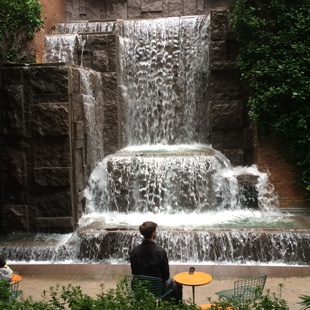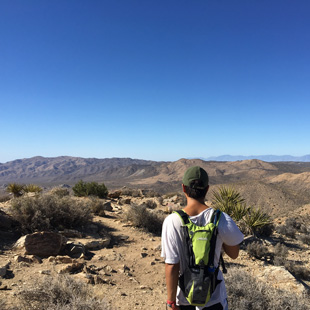Sound Calendar of the Year
“Sound Calendar of the Year” (Ecology Sound Calendar)
Conceived by Jin Hi Kim
 |
 |
| Marc Esposito - Field Recording in New York City |
Harrison Nir - Field Recording in Joshua Tree, CA |
How to participate in the project
The participant’s awareness of and concern for our human living condition, preservation of existing land or animals, environmental issues and the changing sonic environment that is a result of global warming should inspire this collection of sound. The participating audio collectors will submit audio files accompanied by a brief description indicating their names, date, time, location, intent, and the reason for collecting the specific sounds, with a personal description of the experience. (Read Guideline and How to Collect the Sound) They may also submit a photo or a video clip of the scene where the sounds originated. All the participants will be credited in the finished project.
The collected sounds will be sent to composer Jin Hi Kim who will compile and edit them in order to create a new sound installation. Kim will utilize studio time with a sound engineer to edit the materials as well as create the sound mix based on her philosophical and aesthetic choices as well as on-going research and concerns about our changing environment. If the participant submitted more than 10 recordings of different sounds, he/she may create own sound mix (Please consult with Jin regarding the sound mix). At the end of the year, the completed sound mixes will be presented as an exhibition/installation at various locations.
Goals
The public is becoming more aware of the ecological devastation occurring throughout the world with the radically changing environment created by global warming. The pain of high volume of production, climate change, and industrial noise are already directly impacting on millions of people throughout the world and are generating a global awareness of the changing sonic environment. The project will add an aural dimension and heightened awareness through sound of the changes taking place and hopefully initiate a more proactive response by both the academic community and our citizens at large. The project aims to inspire people to both contemplate the current situation and propel them to take action for the good of the planet.
Guideline
When we look at photographs and visuals of horrible environment landscape, we are deeply impacted by and the experience causes us a pain and alerts us to concern about better living environment. In the same way the sound should impact our emotion. If we pay attention to environmental sound every day, monthly and yearly, we are listening to the soundscape surrounding us that is reflection of either human living style or discovery of living environment. Sound Calendar of the Year is a sonic form that juxtaposes existing sounds caused by both nature and human behavior.
Participants will collect sounds with recording devices or smart phones (mp3) of environmental sounds ranging from the sound of nature to urban noise and innumerable other sonic environments as discussed above. They may also submit a video clip or few photos of the site where the sounds originated.
How to Collect the Sound
Please contact Jin Hi Kim at jkim14@wesleyan.edu and let her know that you want to participate in the project. A brief communication about your intent is greatly appreciated.
Do not collect fragments of sound samples. Do not compose/collage the sounds. Do not collect pre-recorded sound or from a sound library. Do not record intentionally composed sound (music or musical instruments).
Record only live/happening sound in any geographic location and any time /date during 2018.
• Think about environmental concern you may have with sound. For example, you may be annoyed by city noise, traffic noise, construction and on-going machine hums surrounding your living space. Why do you want to capture such sound? Do you think people would pay attention to that sound? Why? You may want to inspire people to live in a better sound environment. You may want to share the beauty of natural environmental sound thus inspiring people to be more conscious of natural sound. Did you just discover a new and unusual sound that you haven’t heard before and are very excited to share it with others?
• Find a location where you think that you will capture these sounds.
• Sit there for minimum 5 min. to maximum 10 min. and start recording the targeted sound. You may also record as you are walking for 5-10 minutes. What happened? Did you hear the unexpected sounds? Did you hear unwanted sounds? You will notice that there will be other sounds around the specific sound you are trying to record. These additional sounds come and go. Do not try to avoid those sounds. Please include the whole soundscape as it is happening during the recording session. You have to provide space for those sounds to get in. That is why you need to record 10 min. or more.
• Write down a brief description of your intension to collect the particular sound. Why did you choose the particular sound and location? Describe what have happened during the 5-10 minutes. Were you able to listen to only the wanted sound? Describe how the unwanted sound interacted or interfered with your recording session. Describe new and unsual sounds that you just discovered but you did not pay attention to them before.
• Describe your emotional experiences and any concerns you may have after the 5-10 minutes recording session. What is your thought or inspiration from this experience? Does the recorded sound concern you that our living condition should be changed for better or for worse? Is the sound beautiful but we usually aren’t aware of it because of a lack of our attention or focus? Is it music/sonic art without being intentionally composed?
• If there are no clear nor enough sounds during the 5-10 minutes, please discard the recording and do it again at another time or in a different location.
• Save the recorded sound if you think that it would inspire or influence other people as it did to you. Describe how it inspired or concerned you.
• If you are participating as a volunteer, you may submit one or two sample recordings. Try to record different sound categories, if possible. (Review Suggested Sound Examples) Label each audio file with your name, date, time and location of the recording.
• Send the audio file to jkim14@wesleyan.edu as you finish each time, along with a brief description indicating your name, date and time, location, intent, the reason for collecting the specific sounds, description of your experience during the recording/listening, and your thought or/and inspiration (concern) from the experience. Submit a video clip or a photo taken at the location that shows your reason for collecting the sound. View Submission Form
Technical Advice
Get to know your recording device well and understand its potential and limitations. Be careful of unwanted noise that you may create, e.g. breathing, recorder touching hands or clothes, etc. Review your initial recordings to be sure they reflect the quality that we will need for a public presentation.
Selected Sound Examples in SCY 2018
There are extraordinary range of the recorded sounds including
17 years-cicada brood,
hydrophone under water in the still pond,
desert,
Bangladeshi traffic noise,
humpback whale singing,
frog vocalizations,
birds,
a tsunami,
geese migration,
New York subways,
children playing,
bomb cyclone on a full moon,
sewers,
a hailstorm,
dawn chorus,
dusk chorus,
construction noise,
seashell walk,
SpaceX Falcon,
CT Audubon,
cave,
campfire,
rain and thunder,
ocean,
bees,
katydids,
walking in the city,
water fall,
urban recreational space,
walking on snow,
NASA water deluge system,
Martian wind,
Rain forest,
Elephant drama over night,
Colobus Chorus,
sun shooting,
volcanic eruptions,
geyser eruptions among others.
Suggested Sound Examples
The following lists are categorized by the sound emotionally concerned. Feel free to search your own sound collection according to your intention.
Sounds essential to life
-water sound:
sea waves, stream, rain, tides, boat, fog horn, water drop, flood, ice cracking
-nature field sounds:
trees in motion, wind, individual bird, insects mating, leaves in the forest, flocks of birds, bees, other forest animals
-human breathing:
running, breathing of dying person or sick person, heart beat, baby born
Noise in our urban life
-city & traffic noise:
people’s walking, car, bus, motorcycle, police car, fire truck, ambulance, street noise, train, airplane, highway, airport noise
-industry noise:
construction drill noise, machine noise
Sounds caused by God of action
-sound related to bad weather or natural disaster:
wind storm, rain storm, rain thunder, snow storm, sea wave, ice jam,
melting glacier, geyser eruption, volcano, earthquake, hurricanes
Sounds caused by negative human behavior
-violence sound:
fight, jail, gun shoot, missile, car crash, war, explosion
Sounds of daily repetition
-living room sound:
eating, cooking, sleeping, humming frequency from refrigerator & fan in a room, telephone/cell ring, typing on the computer keyboard, coffee pot, radio/TV white noise
Sounds of labor
-working sound:
factory, elevator, garage door
Sounds of stressed animals and peaceful animals
-animal sound:
animal farm, chicken in a cage, monkey chant, elephant
Sounds of pain
-hospital sound:
machines, patients, mentally ill person’s talk
Sounds of discovery
-unfamiliar sound:
plastic bags, unwrapping paper, flag, chemistry lab sound, underwater, fire, microcosmic sound recorded by special microphone, cracking stone in Joshua tree, rare insect, caves, robot, radio waves in space
Sounds of group synergy
-crowd sound:
New Year’s celebration, demonstration, temple/church ritual, market, funeral, car race, horse race, sport stadium, gym, children’s voice in school, cafeteria & restaurant
Sounds of alert
-breaking news:
Radio & TV news (related to environmental issue)
|